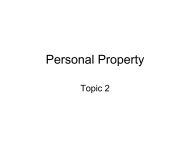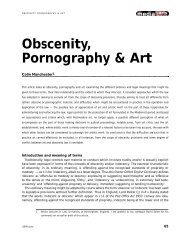Recent controversy over Phillip Gwynne's book Deadly, Unna? and ...
Recent controversy over Phillip Gwynne's book Deadly, Unna? and ...
Recent controversy over Phillip Gwynne's book Deadly, Unna? and ...
Create successful ePaper yourself
Turn your PDF publications into a flip-book with our unique Google optimized e-Paper software.
Gray, ‘Imagination, Fraud <strong>and</strong> the Cultural Protocols Debate’<br />
Similarly, filmmaking is said to be a collaborative venture. Consequently it depends<br />
to an even greater extent than do <strong>book</strong>s upon wheels turning smoothly. Funding may<br />
have been arranged, actors <strong>and</strong> others hired. Shooting within budget may require<br />
completion by a certain date. 14 For both <strong>book</strong>s <strong>and</strong> films, the most practical stage for<br />
consultation to occur is at the initial development of the draft or script. At this stage,<br />
particularly for people without sophisticated English literacy skills, it is arguably<br />
difficult to assess the protocols issue. Further assessment at a later stage may also be<br />
required, <strong>and</strong> is indeed contemplated in existing guidelines. 15<br />
Rights to stories<br />
The second argument is at a more theoretical level, <strong>and</strong> concerns rights to stories. If<br />
indigenous people have rights <strong>over</strong> stories, the argument runs, why should nonindigenous<br />
people not also have rights? At what point does a story become ‘owned’?<br />
Why should non-indigenous people not also ‘own’ rights to stories about contact<br />
between indigenous <strong>and</strong> non-indigenous societies, particularly where there is no<br />
traditional or secret element, <strong>and</strong> where non-indigenous personal histories are also<br />
involved?<br />
A recent example in which this argument has been raised is Australian Rules. The<br />
major issue in the film was not a ‘traditional’ or secret/sacred indigenous story but a<br />
shooting during an attempted robbery in a pub. <strong>Phillip</strong> Gwynne told the Sydney<br />
Morning Herald that ‘[t]he <strong>book</strong> has not tried to appropriate Aboriginal culture. It’s a<br />
white boy’s story <strong>and</strong> you don’t see Aboriginal culture unless you see them through<br />
his eyes.’ 16 This is despite the fact that Gwynne, who based much of the <strong>book</strong> on his<br />
own teenage experiences, was not actually in Port Victoria at the time of the shooting,<br />
<strong>and</strong> other key details have been changed. 17<br />
14 Sally Riley, the manager of the indigenous unit at the Australian Film Commission, stated of the<br />
Australian Rules script: ‘They consulted too little too late. By the time they talked to the community,<br />
the wheels were turning, actors were hired. They could’ve helped the community get <strong>over</strong> the pain <strong>and</strong><br />
anger of the deaths. Something good could have come out of it, but they didn’t.’ See Peter Ellingsen,<br />
ibid.<br />
15 See SBS protocol, above n 2, 29: ‘Once the likely aims, procedures <strong>and</strong> consequences of any<br />
research, interview etc have been explained clearly, as pointed out above, the right of consent or refusal<br />
to be used or to participate in the research still remains with the subject(s) of the work, regardless of<br />
whether consent or refusal had been made before.’<br />
16 Quoted in Mark Mordue, ‘White Words, Black Spaces’, HQ Magazine, June 2002.<br />
17 The white boy Blacky’s Aboriginal mate, Dumby Red, who was shot dead in the film, is in fact still<br />
alive. The real victims were two other Aboriginal youths. The real shooter was a publican, Antonio



![ERIN O'DWYER [92] Introduction Striking a balance between ...](https://img.yumpu.com/14667367/1/184x260/erin-odwyer-92-introduction-striking-a-balance-between-.jpg?quality=85)


